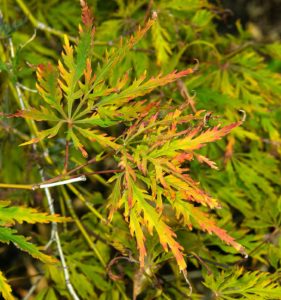With temperatures approaching or exceeding 95oF for many areas of the state, there is potential for heat stress to negatively impact nursery and landscape plants both in the ground and in containers. Most trees and shrubs in our area can begin to experience some degree of heat stress when temperatures exceed 85oF. Several factors can influence the extent of heat stress injury, including the severity and duration of high temperatures, relative humidity, wind, soil moisture status, the age and condition of the plant, and how well the particular species of plant is adapted to dealing with these conditions.

Leaf Scorch on Japanese Maple caused by heat stress. Photo Credit.
Heat stress can cause damage to the leaves, resulting in dried or curled edges, as well as reddish or pale coloration as the green chlorophyll pigment begins to break down. This damage may only be superficial, but in some cases it could cause serious injury and death of the leaf tissue. One factor that greatly affects the severity of tissue damage caused by heat stress is the hydration status of the plant before the onset of extreme temperatures.
Plants will naturally dissipate heat through the process of transpiration, provided there is adequate moisture in the soil to support this function. During periods of extreme temperatures, the roots will struggle to draw enough water from the soil to keep up with the rate of water vapor that is exiting the leaves through transpiration. This leads to symptoms such as leaf scorch, curled leaves, discoloration, defoliation, die-back, and temporary wilting. Because the plant is experiencing stress and a disruption in its normal physiological functions, it becomes more susceptible to insect and disease problems.
There are several preventative measures that can be taken to reduce the impacts of heat stress in nursery and landscape plants.
- Thoroughly water plants either in the evening or in the early morning before extreme temperatures occur. Water the plants deeply and use irrigation methods that minimize leaf wetness to reduce the potential for foliar diseases.
- Properly mulch plants to conserve water in the soil and help lower soil temperatures. Bark mulch, leaf mulch, straw, and other organic mulches will help to lower the temperature in the root zone, while gravel mulches can actually increase root zone temperatures. Be sure to provide additional water to newly mulched plants to prevent dry mulch from taking moisture away from the roots.
- Avoid fertilization during periods of heat stress because this can absorb moisture in the root zone and further contribute to dehydration of the plant.
- Avoid applying herbicides that can volatilize in high temperatures and drift, causing damage to non-target species.
- Pay special attention to plantings that are located next to driveways, concrete patios, or other structures that can absorb and radiate additional heat to the plants. These areas will likely require additional irrigation.
Additional Resources:
How to Protect Trees and Other Landscape Plants from Heat Stress

